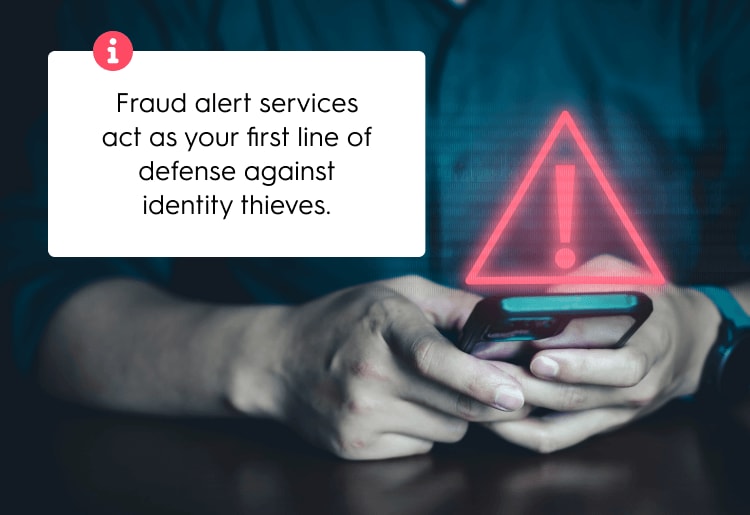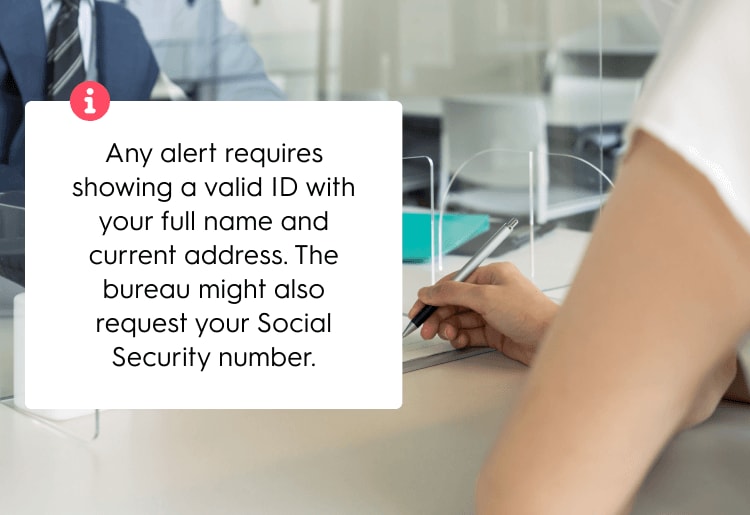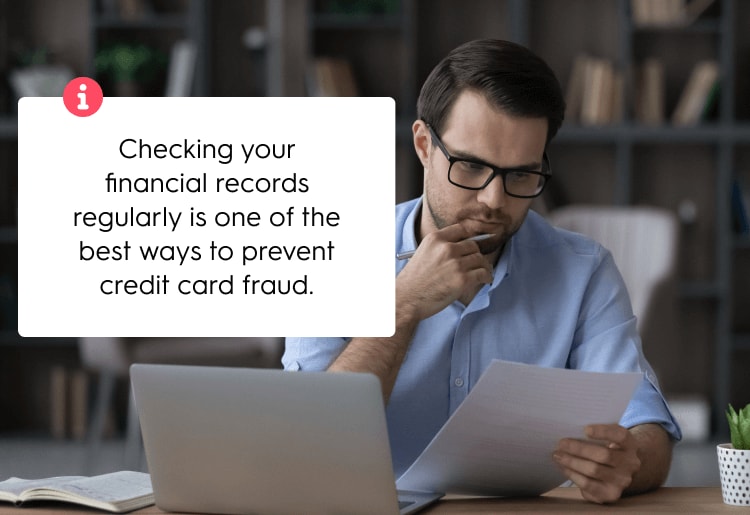Drawing from my experience in private equity and finance, I'll guide you through placing and removing fraud alerts, explain why they're essential, and mention the different types of alerts available.
We'll also compare fraud alerts to credit freezes and discuss how identity theft services like myFICO can safeguard your financial well-being. With this knowledge, you'll know what to do if you're a victim of ID theft.
» Uncover the ways hackers steal your ID and how to prevent them.
What Are Fraud Alerts and Why Do They Matter?
Understanding Your Credit Report and Score
Your credit report and score are crucial to your financial well-being. They influence the interest rates you're offered on loans, your ability to rent an apartment, and even your job prospects.
Credit reports summarize your credit activity and payment history, while your credit score is a single grade that reflects your creditworthiness. Inaccurate information on your credit report, particularly false entries, can severely impact your score and may indicate that you've fallen victim to identity theft.
How Fraud Alerts Help
Fraud alert services act as your first line of defense against identity thieves. By placing a fraud alert on your credit report, you instruct bureaus and lenders to take extra steps to verify your identity before allocating funds in your name.
Services like IDShield can help you set up these scam warnings and provide additional layers of protection to avoid these nightmarish stories from real ID theft victims.
This simple step can prevent fraudsters from causing significant damage to your financial life, saving you from the stress and costly consequences of identity theft.

How to Place a Fraud Alert on Your Credit Report
1. Contact a Credit Bureau
You can file a fraud alert by email, online, or phone. The US has three major credit bureaus: Equifax, TransUnion, and Experian. Here are the contact details for each of them:
Equifax
- Online: Go to Equifax's website and make an account. You'll need to give your name, address, and birth date.
- Phone: Call Equifax's fraud alert line at 1-800-525-6285.
TransUnion
- Online: The quickest way is through TransUnion's website. Make an account and provide your contact info and birth date.
- Phone: Call TransUnion at 800-916-8800. Make sure you have your Social Security number.
Experian
- Online: Visit Experian’s website and sign up. Just give your contact details and birth date.
- Phone: Call Experian at 888-397-3742. Remember to have your Social Security number ready.
2. Choose the Type and Duration of Fraud Alert
Inform the credit bureau that you want to place a warning on your financial report, then specify which type of alert you're requesting and if you've been a victim of ID theft. The different types include:
Initial alert
This simple 90-day warning is the easiest way to protect your credit. It's particularly helpful if you suspect your financial information has been compromised due to a lost wallet, data breach, or phishing scam.
Extended alert
This alert is valid for seven years (non-renewable) and is available to confirmed identity theft victims. It requires submitting evidence, like a police or Federal Trade Commission (FTC) report.
It's appropriate if you find unauthorized accounts, unfamiliar charges, or disputes over transactions you didn't make on your credit report.
Military alert
This policy is designed for armed forces members like the Army, Navy, and Coast Guard. It helps safeguard your credit while you're serving abroad. You can authorize a personal representative with Power of Attorney to place an active duty alert on your behalf.
3. Get Your Documents Ready for Verification
The documents you need depend on the fraud alert you choose. Any alert requires showing a valid ID with your full name and current address. The bureau might also request your Social Security number.
Extended and military alerts could call for extra paperwork. For example, you must provide your official orders if you're deploying with the armed forces.
Here's a list of documents you may need to file an alert:
- Transaction details: Gather information about the unauthorized transaction, including the merchant, amount spent, and transaction date.
- Proof of identity: Provide documents that verify who you are.
- Billing Statements: Keep copies of credit card statements showing the fraudulent charges.
- Police Reports: If applicable, include any police reports related to the fraud.
- Correspondence: Save any communication regarding the fraud claim with your credit card issuer.
- Identity theft affidavit: You can download an Identity Theft Affidavit or fill out Form 14039 online through the IRS to help document the details accurately.
- Evidence of fraud: Collect evidence supporting your claim, such as screenshots, emails, or social media interactions.
5. Confirm Your Alert
The bureau you contact notifies the others, and the alert shows up on your credit report. You'll get confirmation of the alert when you request your financial information from each agency.
You can also download a copy of your report from the FTC website for free once a year. The site has free ID fraud resources that can guide you on how to report identity theft to the FTC.

» Feeling watched? Read what to do when your Social Security number is stolen.
How to Remove a Fraud Alert
1. Choose a Contact Method
You can contact your preferred credit bureau over the phone, online, or by email. Remember to have all your information and identification ready to help answer any questions with the correct details.
2. Verify Your Identity
You'll need to give details such as your complete name, residence, and Social Security number. These details help the bureau ensure they speak with the correct individual.
3. Confirm Authorization
After confirming your identity, you need to authorize the removal of the fraud alert. The bureau will ask you directly if you want to remove the alert from your credit report since they can only cancel it with an official confirmation.
4. Provide Additional Documentation (if applicable)
Depending on your circumstances, you may also need additional documentation. For instance, if you're an active military member stationed overseas or previously a victim of ID fraud.
Keep the necessary documentation to ensure a clear record of who placed or removed the alerts. This enhances accountability and verifies that you're initiating these actions, not someone else.
Here's a list of documents you may need to remove an alert:
- Resolution documentation: If you’ve resolved the issue with the credit card issuer, keep records of the resolution.
- Confirmation of fraud resolution: Obtain written confirmation that the fraudulent charges have been removed from your account.
- Updated filling statements: Ensure your subsequent billing statements reflect the corrected account balance.
- Identity theft report: Create an identity theft report with the FTC and provide it to the credit bureaus.
- Supporting documents: Attach any relevant documentation, such as receipts, police reports, or evidence proving your absence during the fraudulent charge.
Fraud Alert vs. Credit Freeze: Pros and Cons
A fraud alert tells creditors to take extra steps to confirm your identity before granting funds in your name. A credit freeze, however, locks down your credit report entirely, preventing anyone from accessing it.
Both methods help protect against identity theft, and you can select the one that best fits your needs.
Credit Freeze
Pros:
- High security: Freezes provide strong protection by blocking access to your credit report. No one, including you, can open new accounts while the freeze is in place.
- Instant control: You can turn credit freezes on instantly, giving you control over your credit report's accessibility.
- Free to set up: You can place it at no additional cost at all three major bureaus (Experian, TransUnion, and Equifax).
Cons:
- Inconvenience: To lift a freeze, contact the bureau and give them your unique PIN. Afterward, you'll need to refreeze your credit by repeating the same process, which can be a hassle if you're dealing with several bureaus.
- Delayed access: If you want to apply for credit, you’ll need to lift the freeze beforehand, which may cause delays as the process isn't instantaneous.
- Lack of options: A freeze is permanent until you request it to be lifted. There are no temporary options available.
Fraud Alerts:
Pros:
- Less restrictive: Fraud alerts allow businesses to access your credit report after verifying your identity, as they don’t block access entirely.
- Multiple Options: You can choose between a temporary fraud alert (one year) or an extended fraud alert (seven years).
- Free to set up: Like credit freezes, fraud alerts are free.
Cons:
- Limited protection: These alerts notify creditors to verify your identity but don't prevent access to your report.
- Short duration: Temporary fraud alerts expire after one year, requiring renewal. Extended fraud alerts last longer but require documentation (such as a police report).
Does a Fraud Alert Affect Your Credit Score?
A fraud alert doesn’t directly impact your credit score. Instead, it acts as a warning for lenders. When you place an alert, and a lender checks your credit for a loan, they must verify your identity thoroughly. This might cause a slight delay in credit applications due to the extra validation steps.

Can Fraud Alerts Impact Credit Access?
Fraud alerts can make it a bit harder to access your credit. Financial institutions will conduct more thorough verification processes. These can delay opening a new line of credit, like a loan.
Also, access could require additional verification steps. For example, creditors may need to contact you directly using the phone number you gave when placing the alert to verify your identity.
How Does ID Theft Impact Your Credit Report?
Identity theft can seriously damage your credit report. Protection services like Norton and IdentityIQ can help reduce the impact in multiple ways:
- Monitoring: They constantly check your report for red flags, such as new accounts or odd changes in your score. Catching issues early stops further harm.
- Recovery assistance: If you become a victim, these services walk you through the recovery steps. They help you contact credit bureaus, file reports, and dispute fraudulent activity.
- Reimbursement: Many offer insurance for legal fees, lost wages, and unauthorized transfers.
- Proactive safeguards: Tools like dark web monitoring search hidden sites for your personal info to avoid misusing it.
» Take control of your security with these LifeLock alternatives.
Is a Fraud Alert Effective for Credit Inaccuracies?
A fraud alert's primary purpose is to protect you from identity theft. When you suspect fraudulent activity, placing a fraud alert notifies lenders that they need to verify your personal information more thoroughly.
However, you’ll need to take different steps to deal with report errors. For example, you can dispute the incorrect information directly with the credit reporting agency.
Fraud alerts and credit disputes have different purposes, but both support the accuracy and security of your financial information.
Practical Tips to Monitor Credit Cards
Here are a few ways to protect your personal information from cybercriminals and monitor your credit card to avoid being scammed:
- Regularly review your statements: Check for unfamiliar charges or transactions when you receive your credit card statement. If you spot something unknown, investigate it right away.
- Identity fraud protection services: ID protection services like Aura and LifeLock will show you how to check for identity theft or monitor your personal information and credit for you. They also offer identity theft insurance and fraud alerts from multiple bureaus.
- Set up account alerts: Most banks and credit card companies allow you to set up alerts. These notify you instantly via email or text when certain activities occur on your card. For example, you'll know when a large purchase is made, or your balance reaches a specific limit.
- Monitor your credit card activity online: Frequently log into your online banking or credit account. Look at recent transactions to make sure everything adds up. If you see anything suspicious, report it promptly.
- Check your credit report often: Checking your financial records regularly is one of the best ways to prevent credit card fraud. Look for errors or signs of identity theft, such as missing statements.

Enhance Your Security With Alerts and ID Theft Services
Fraud alert services are crucial for keeping your identity and credit safe by acting as early warning systems against scams. Different alert types or a freeze are perfect for short-term and long-term security.
ID theft services, like Identity Guard, can provide added layers of protection by actively monitoring your personal information. Using these services alongside fraud alerts can enhance your overall security.
» Find out how to protect yourself from phishing attacks.

